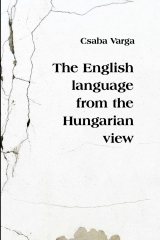The English language from the Hungarian view
The research to find the proto-nostratic language of Eurasia lately brought more and more results. One of those discoveries is the recognition that a big part of the English vocabulary – as presented in this book – has much more similarity to the Hungarian than we thought before. These similarities are touching the basic elements of both languages. An important detail of this recognition is that we do not have to move people forth and back all over the continents to explain “takeover”- words. The common features are the legacy of an archaic root-language, once spoken by everybody in Eurasia. The recognition of so many common words could be quite useful for Hungarians learning English and vice versa.
A few words to train our assessement
Articulate loudly these words and you may hear two different dialects instead of two languages.
babouch = papucs <papuch>
bezoar = bezár <bεzaar>
bare = pőre <pœrε> {delivered from bőr (skin),
it is being used as “naked”.}
cheapen = csappan <chappan> (getting smaller)
chimney sweeper = kéményseprő <kemenjshεprœ>
chide = szid <sid>
chink = cseng, csengés <chεngesh>
chirrup = csirip <chirip>, cirip <czirip>
chisel = csiszál <chisaal>,
chop = csap <chap>
harsh = hars , harsány <harshaanj>, érdes
heap = hupa
hoard = hord (össze-hord: carrying together)
house = ház <haaz>
leak = lék, luk
loch, lakelet = luk, (small bay)
loose = laza
lumpish = lompos <lomposh>
mellow = málló
mere = merő <mεrœ>
muck = mocsk (mocsok) <mochok>
neck = nyak <njak>
night = nyugt <njugt>
pis (piss) = pisi <pishi>
poorhouse = pórház (szegényház)
posh = pos(vány) <poshvaanj>, pos(had) (stale), pocs(olya) <pochoya> (puddle)
puff = pöf, pöffen <pœffεn>
puffed = puffadt
sack = zsák <žaak>
stellar = csillár <chillaar> (luster), csillan (sparkles), csillag (star)
tag, a loose end = vég-tag (end-tag, limb)
tusk = tüske <tueshke> (thorn), agyar
wander(ing) = vándor(lás)
wasted = vesztett <vεstεtt> (lost)
waste = puszta <pusta> (desert, bare),
= veszt <vεst> (loses)
= foszt <fost> (strips)
= puszt(ít) <pustiit> (destroys)
There is very little difference between the two sides of the word pairs above (except the chimney sweeper). The variation is less than in the case of “bishop” in different languages: püspök – episcopus – wiskup – Bischof – vescovo – and in Turkish it became a “beg”>> pisbeg.
Even the inflection (agglutination) of words is the same on both sides, as you will see later on in other examples.
The first part of the book introduces the Hungarian language
THE AGGLUTINATION
The word agglutinating means adding, gluing, putting pieces together: adapting them one after the other. It is a special way of building words. The added pieces might be categorized in different groups: suffixes, attributes etc. We do not differentiate now; we call them all together suffixes or prefixes. Languages, which build their words this way, are called “agglutinating” or agglutinative.
Hungarian is a well-known member of this language group. It has far over a million words built this way holding on to very tight rules.
Every word starts with the basic root, which is the subject of agglutination. This contains and only this contains the main topic, the fundamental meaning of the word. For example: the words
tolong (jostling),
tolatás <tolataash> (shifting),
tolakodhattok (you all might jostle) were not understandable without the word “tol” (he/she is pushing). There are over fifty entities built from “tol”, which itself is already an agglutinated form. The basic root (root-morpheme) is “to or tá” that means distant from the person, who says it. A mother tells her little child – going for a walk – that “we are going ta-ta.” This “to, tá” are to find in the words
távol (far away), tova (away, gone),
tavaly <tavay (last year),
tolul (one’s way trough a croud),
tolóka (slide), toldoz (he patches up).
*
All the suffixes are full-fledged words with independent sense and full importance. The meaning of many suffixes became unclear with time and the sound of some got modified. Many suffixes are still fresh words in every day’s use. The complete, ancient, probably original way to build words could certainly be recognized and demonstrated with the help of words, in which the meaning of the word building elements (suffixes) are still explicable.
We call a vocabulary agglutinative for it’s organic structure. And we have to accept this fact with all it’s consequences.
In the first place and fundamentally, we have to acknowledge and accept that an agglutinative language built from basic word roots is one of nature’s miracles, which is as beautiful as life itself. With all this we were able to look into nature’s language-building workshop.
*
Zoltán Simon was much engaged with the similarity of the two languages (see the list of references). He wrote the next two sentences, which are identical with minimal grammar adjustments:
Ten old angry chimney-sweepers went across the swampy medow to the curtis lodge’s wall
Tíz ódon ingerült kémény-seprő ment keresztül a zsombékos mezőn a kertészlak falához
<žombekosh>
to eat fresh fine cock-neck and water from a brownish cup
enni friss finom kakasnyakat és vizet egy barnás kupából
<kakashnjakat>
We may take the end of the sentence again:
[In Hungarian esz, enni does have an ét variant.
[sz>t] like // vesz > vit(el) (take – carriage),
or isz > it(al) (drink)] //
ét számos friss finom kakas nyakat
eat some fresh fine cock neck
*
The second half of the book deals with similarities and
common features in both languages
It is like looking for diamonds in the sand. Having found them and admired them, we may follow an etymological dictionary containing over 700 words.
*
Finally, see “The summing up the etymology”
and the “Postscript” later in the book.

